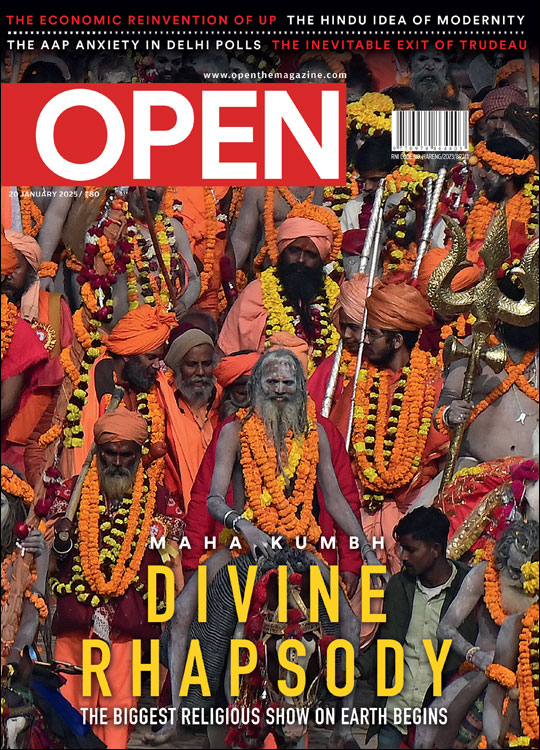The Great Escape from Monogamy
How couples are redefining the partnership protocol
 Mihir Srivastava
Mihir Srivastava
 Mihir Srivastava
|
24 May, 2012
Mihir Srivastava
|
24 May, 2012
/wp-content/uploads/2015/11/partners2.jpg)
How couples are redefining the partnership protocol
‘Relationships—of all kinds—are like sand held in your hand. Held loosely, with an open hand, the sand remains where it is. The minute you close your hand and squeeze tightly to hold on, the sand trickles through your fingers. You may hold onto some of it, but most will be spilled’
~ Kaleel Jamison, author of The Nibble Theory and The Kernel of Power
For most middle-class Indians, an ‘open relationship’ is an oxymoron. Some insist it’s just a fanciful notion that has somehow gained currency, that no such thing exists in practice. For them, monogamy (or you might hear ‘fidelity’ or ‘conjugal loyalty’) is the foundation on which any marriage or sexual relationship rests. Is it possible to change the basis of such a relationship without it falling apart? For the cynics, the question is rhetorical.
Fact is the idea of an open relationship has many takers in India. Moreover, as its successful practitioners attest, such an arrangement can last as long as any other relationship. Sceptics consider it a compromise option for unhappy couples, but those in an open relationship see it as an acknowledgment and acceptance of—even respect for—their partner’s needs. It is an agreement of equals, they say, that reflects parity as much as clarity and confidence between couples. Potentially thorny issues of how children would deal with it, complex emotions of jealousy and possessiveness, its fallout on one or the other partner’s self-esteem and/or sexual health, all seem to recede when couples commit themselves to it.
An open relationship could be maintained by any couple, heterosexual or gay, married or live-in, staying together or living apart, and it makes space for a variety of other sexually satisfying encounters: short dalliances or sustained alliances with members of the same or opposite sex.
Among those perplexed by popular cynicism about the phenomenon is Saleem Kidwai, a scholar of medieval Indian history, who has written about gay practices in Islamic societies, and is co-editor of the book Same-sex Love in India: Readings from Literature and History. “Look at the quantum of non-marital sex happening everywhere,” he says.
Upholders of an open relationship are emphatic that it is not just about carnal fulfillment. It has an emotional facet, and there are codes of conduct that govern such a relationship— it is not a licence for free sex. Most couples devise their own set of rules. To begin with, the primacy of their own relationship is a must. Under this ‘partner prerogative’ rule, each must always be there for the other. Other terms could vary from a set of disclosure norms on identities, etcetera (with limits on intimate details) to keeping common friends out of the picture. “I would hate it if my best friend were to discuss my husband’s performance in bed with me over a cup of tea,” says a 38-year-old academic who lives in north Delhi. She has been married for 12 years to a merchant navy captain, and the past ten years of this relationship have been open.
While such rules safeguard the relationship, some argue— counter-intuitively—that the openness actually consolidates it. “Among gay-men couples,” says Kidwai, “an open relationship actually helps cement ties between them.” The same could be said of heterosexual and bisexual couples as well. Despite claims about evolution having encoded males with a special preference for multiple partners, modern mores of gender equality suggest that the emotional dynamics between any two partners are universal, whatever their gender or sexual orientation.
Consider the views of Eric Anderson, author of The Monogamy Gap: Men, Love and the Reality of Cheating. As a sociologist, his research focuses on men, but he collates the work of psychologists, biologists, anthropologists, even endocrinologists, to suggest that human beings by nature are uneasy with monogamy. ‘It’s a fashionable social expectation, but not a biological desire. This means that there is a gap between what we want sexually and morally,’ he writes, ‘Interestingly, the relentless urge to have sex with someone other than one’s lover grows stronger as the emotional strength of the relationship develops. When every cell in their body is craving sex with someone else, monogamy begins to feel like sexual incarceration.’
The obvious way out of the monogamist’s dilemma is a sexually open relationship. Anderson defines it well: ‘Here, in an egalitarian manner, a couple reserves emotional fidelity, while structuring in rules for extra-dyadic, recreational sex.’
Take the case of this would-be filmmaker who describes herself as “a person who takes her own decisions” and has been in an open relationship with a 25-year-old theatre artiste/activist for the past two years. A dusky 23-year-old who has just finished a four-year mass communications course at Delhi University, she remembers her flings quite fondly. She has had one with a French backpacker while travelling across India for a month, another with a documentary filmmaker, and yet another with a successful professional 20 years her senior, among others. “I did not feel guilty about it,” she says, “I told my partner what is happening in my life. I was not there to seek his permission, just to inform him.” Her association with the French backpacker, she let him know, was a special one. Travelling together, they developed a liking for each other that culminated in sex. “I am not repentant or guilty. There is a distinct possibility that it might happen again,” she told her partner. “It’s okay,” he mumbled in response. They haven’t discussed their flings since, though she often hears of her partner’s sexcapades through common friends. Puzzled acquaintances often ask, “Are the two of you still together?” Her reply is always a cheerful “Yep” with a big smile.
For a married woman, it may seem slightly more complicated. A journalist in her early thirties who has had an open marriage for six years calls it “just a phase” in her life. She lives with her graphic designer husband in Delhi, and they have a five-year-old son. Their relationship was thrown open by accident; they both had an extramarital affair, and that led to this. “I was not hurt by the fact that he was sleeping with another woman, but that he did not tell me about it,” says the journalist. They decided to be transparent with each other about their affairs, and both have had several since, but they retain their original bond as “soulmates”. She is even friends with her husband’s girlfriend. “When I am away on a tour, I invite [her] to stay in my house. I feel relaxed that my husband is not alone.”
Sometimes, an open relationship takes time to develop. Sriram, a 37-year-old copy editor who insists on a face-to-face interview at a coffee shop, says he and his wife “evolved an open relationship” after starting off as a “normal couple”. He means ‘monogamous’, and he quickly corrects himself to say that “there is nothing abnormal about being in an open relationship”. His wife is a 34-year-old academic who dubs her sexuality ‘bi-curious’. They had married ten years ago, and he moved from Kolkata to Delhi to be with her. They would often discuss issues of sexuality, monogamy and gay rights, but never thought they would be in such an adventurous arrangement. But once they both had separate rolls in the hay around the same time, they discussed their need for alternative experiences. Such affairs, they realised, would recur, but instead of clamping down on their urges, they decided to be forthright about it with each other. “An open relationship is about sex, but not just sex,” says Sriram.
At first, they would discuss each other’s adventures threadbare, but that would freak Sriram out, so they decided to dispense with the details. “It is not always easy for me,” he says, admitting that “my inflated male ego is hurt when the spillover of her other relationships affects our time together”. But this, he feels, is a small price to pay for not having to “suppress our desires and emotions”. Their parents are unaware of it and they have no children.
Sriram agrees with the veteran gay activist Ashok Row Kavi—who lives in Mumbai and has been associated with UNAIDS for a long time—that humans are not monogamous creatures. “I have always been in open relationships. For four decades. In a gay relationship, the more open it is, the more honest it is,” says Kavi, who says he has a variety of relationships with different people. “They are all a source of strength to me,” he says. Some are libidinous in nature, some are spiritual, and others are intellectually stimulating. Sex is the common link. Jealousy and insecurity may sometimes cloud one’s life, says Kavi, but one just has to deal with it. “It’s not easy to compete with a woman,” he says. His chosen family, he adds, is “a modern one where there is room for all: lovers, partners, bisexuals, everyone.”
Relationships tend to take their own course. For many, the need for social sanction is irrelevant, so long as they are satisfied with the privacy of their own enclaves. Consider the case of a 55-year-old lecturer in a big town of Kerala, who has had an open relationship with a social activist for the past 30 years. “There is no compromise in being in an open relationship. In fact, we were willing to make no compromises,” she says with a self-assured air of finality, “We respect each other and our needs.” They never got formally married. “From the very beginning, we decided to be candid about what is happening in our lives and not to cheat on each other.” For work-related reasons, they have not been living together lately, but they have a 26-year-old daughter who respects their decision. “She is like us,” says the lecturer. Given Kerala’s conservatism, however, it was not always easy. Her parents were disturbed when they first learnt of the arrangement, but eventually came to accept the nature of their relationship.
The open relationship is not a privilege of just the middle-class, evidently. The working class is rippling with examples, if one only cares to enquire. Bahadur, a lanky 27-year-old with sharp features and a fair complexion from an agrarian family in Agra, is a part-time pimp who has an open marriage with Sheela, a 25-year-old Bengali girl who is a part-time sex worker. Bahadur also has a day job as an inventory clerk at an export firm in Noida, and he got Sheela from Kolkata to Delhi some three years ago. “I fell in love with her at first sight,” he says. They got married a year ago, and have since been living together in Shakurbasti, a north Delhi suburb. “I have many women in my life. Sometimes I sleep with rich aunties for Rs 5,000 a night,” he says, “But Sheela is and will always remain the love of my life.” He seems cool about his wife’s profession. “Prostitution is her source of income,” he says, without batting an eyelid, “She wants to be independent. But at the end of the day, she only wants to come home to me. One day, we will have many children.”
Bahadur has never heard of an ‘open marriage’, but once it’s explained to him, he shows instant recognition. “I am in an open marriage,” he says, with a grin. And he is full of examples of such relationships among his peers. Life in a metropolis like Delhi, he explains, is very hard for the poor—especially migrants. They need both emotional and financial support, and open arrangements are quite practical. “There are many odd couples living together in the city,” he reports, “They pair up as a survival measure”—even if their sexual interests lie elsewhere. His 33-year-old friend Sudev, with whom he has bought a small plot of land in Ghaziabad, “lives with two women and a man, all sexually active with each other, in a singleroom dwelling in Badarpur.”
Such cosy arrangements among the middle-class tend to be a lot more discreet, though they’re not without their exigencies either. Take the complicated case of a doctor couple in their mid-thirties. Theirs was a love marriage, and after seven years of marital life, they have two children and live in Mumbai. The wife speaks strictly on condition of anonymity. Both she and her husband have multiple partners within a closed group of a dozen men and women. “We are swingers,” she says, with a laugh, “but on a serious note, we are very careful about our partners.”
The first year of their marriage was like a dream come true. But then things started going awry between them. “Something was wrong,” she recounts, “We had a frank chat after my husband told me about his desire to sleep with men—if and only if I’d allow him.” Her immediate reply was an unconditional ‘no’. He accorded her decision the respect it deserved, and she is glad that he never lied to her about his past, flings and feelings. In fact, he’d told her of his bisexuality before they got married. It had pained her for a while. During her early phase of torment, she was strongly attracted to a colleague of hers, “as a rebound perhaps”. Aware that he was suffering a denial of his natural desires too, she began to empathise with him, and they both went for counselling.
“I could have taken a moral position and ruined my marriage,” she says, “The solution was to renegotiate it.” They had to start afresh—in an open relationship. She had her moments of reluctance. It was too demeaning, she felt, just a sorry compromise. “I would cry, thinking ‘My life is doomed, I love a gay man.’ But ever since we struck this arrangement, he is happier than ever before and has filled our relationship with happiness. We were blessed with two beautiful children. Now I don’t have regrets anymore.”
It’s a Catch-22, as Anderson explains: ‘Focusing on the problem of cheating distracts us from focusing on the problem of monogamy. Long-term sex with just one partner leads to less sexual desire for that partner, regardless of the strength of the emotional relationship.’
In other words, for all that conservatives have to say, monogamy may not be everything it is cranked up to be, and certainly not the key to a lifetime of sexual satisfaction, even if it confers a range of well-acknowledged benefits. Anderson points out that 13 million people from 22 countries are looking to have an extramarital affair on AshleyMadison.com alone. There exist several other such sites with large numbers of Indian would-be sexual surfers. ‘For many,’ as Anderson writes, ‘monogamy is more of a desire than practice’. And, mind you, no matter what some scholars of our descent from apes claim, ‘This is true of both men and women.’

/wp-content/uploads/2025/01/Cover_Kumbh.jpg)











More Columns
The lament of a blue-suited social media platform Chindu Sreedharan
Pixxel launches India’s first private commercial satellite constellation V Shoba
What does the launch of a new political party with radical background mean for Punjab? Rahul Pandita